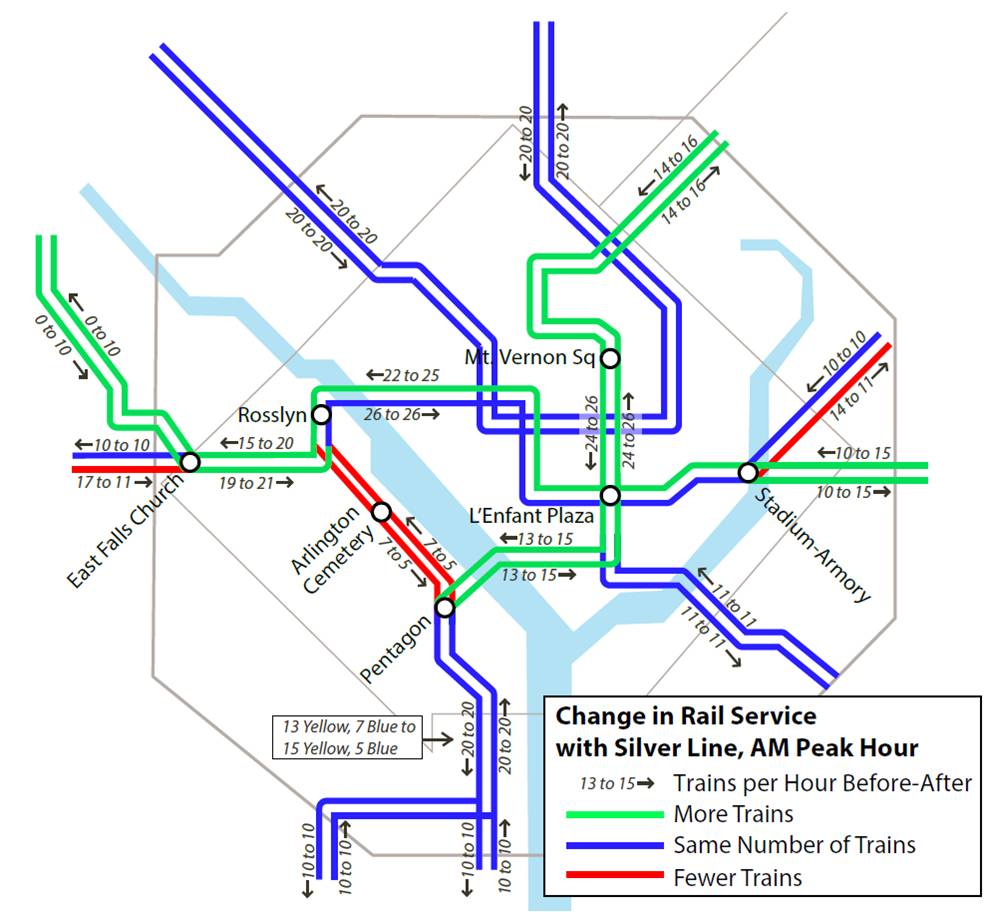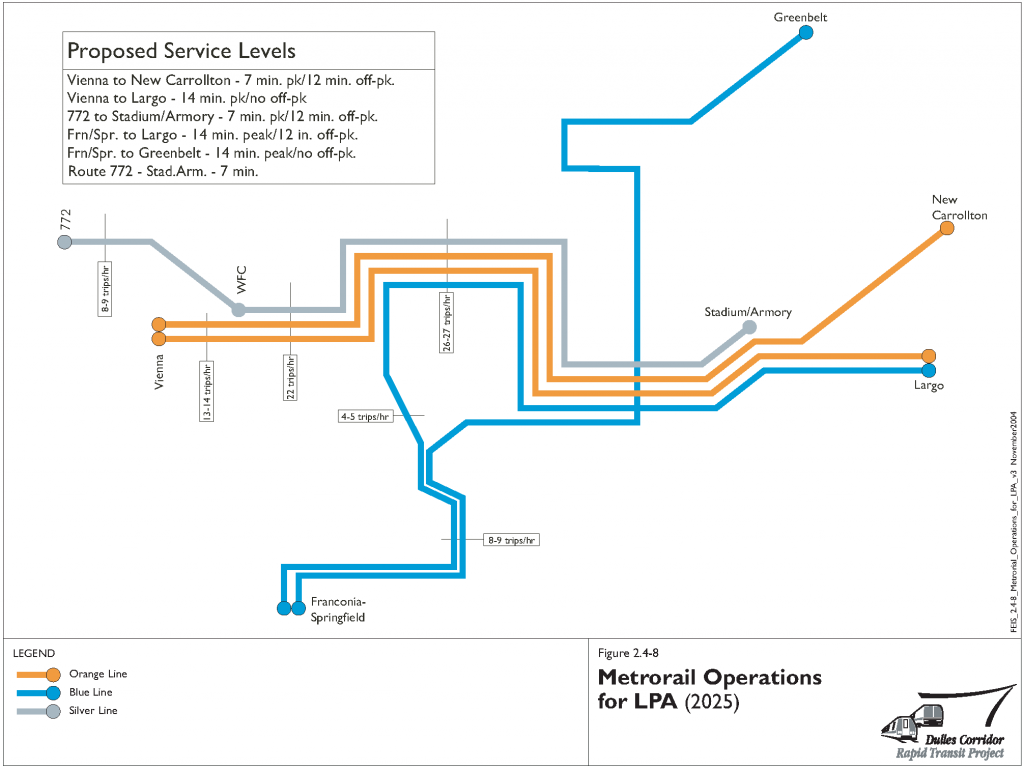Silver and Blue Line Changes: Over a Decade in the Making
Recent and upcoming Metrorail service changes to accommodate the Silver Line have been in the works for over a decade, and are better for Blue Line riders than originally planned.

Metrorail Service Changes with the Silver Line Opening on July 26, 2014
Why Does Blue Line Service Have to Change?
The upcoming July 26th opening of the Silver Line has been a big story of late, and for good reason. In order to accommodate the Silver Line trains merging onto the existing tracks, through the Rosslyn tunnel and into DC, Metro has to reduce rush hour service on the Blue Line to make room. This is because the existing infrastructure cannot reliably accommodate more than 26 trains per hour at any point, so to add service on one line, another line must see a reduction in service.
When Did the Idea for This Start?
The idea for a rail line to Dulles Airport has been discussed as a concept since the 1960s. More recently, the project development and environmental review process began in 2000, with the initiation of environmental studies in the Dulles Corridor. Simultaneously, plans were developed to restructure service on the Blue and Orange lines in order to maximize Metrorail capacity across the Potomac River. This so called “Blue Line Split” was first recommended in Metro’s Core Capacity Study in 2002, and then incorporated and finalized with the publication of the Dulles Corridor’s Final Environmental Impact Statement (FEIS) in 2004. Metro’s Board of Directors approved the FEIS with Metrorail as the preferred alternative on September 16, 2004. The Metro Board-approved FEIS analyzed the impacts in the Dulles Corridor, including the service changes that would be required for the Silver Line to be accommodated by the existing Metrorail System (PDF), including:
- Adjusting the frequency of rush period Orange trains, with some shifted to Largo Town Center
- Shifting some Orange Line trains over to the new Silver Line through Rosslyn
- Shifting peak period Blue Line trains over the Yellow Line bridge to Greenbelt
Rush Plus
In June 2012, Metro made changes to partially implement the “Blue Line Split,” called Rush Plus. This change added 3 additional Rush Plus Orange Line trains per hour per direction between Vienna and Largo Town Center, and 3 new Rush Plus Yellow Line service between Franconia-Springfield and Greenbelt. The change also resulted in 3 fewer Franconia-to-Largo Blue Line trains per hour in each direction in order to make room at Rosslyn and boost overall cross-Potomac capacity.
Recent Adjustments Help Riders
As you can see from the two graphics, the 2004 plan projected a Blue Line train about every 14 minutes during rush hour. As the Silver Line opening approached, Metro was able to more precisely balance the needs of the Silver and other Metrorail lines, in order to provide 12 minute rush hour Blue Line service. Also, instead of terminating at Stadium-Armory, the new Silver Line will terminate at Largo Town Center (PDF), adding more service for riders in that corridor. In addition, Metro will be shifting more 8-car trains to the Blue Line to reduce crowding and further increase capacity across the river.
What’s the Plan to Improve Potomac River Capacity?
Metro’s new strategic plan, Momentum, calls for initiatives to increase Metrorail capacity by going to 100% 8-car trains on all rail lines, and investing in core station improvements. But we need your support to obtain the funding to make these needed improvements. Please visit our plan webpage, and endorse Momentum today.



Only in Metro world is 12 minutes between trains better than 6 minutes between trains! Don’t insult our intelligence. “It could be worse” is hardly comforting to those of us required to pay rush hour fares for this ridiculously limited amount of service.
Are you KIDDING ME? Less Blue Line service? Just when I thought Metro couldn’t go anyl ower.
The upcoming reduction (yet again) in Blue Line trains to Rosslyn and through DC to Largo when service starts on the new Silver Line simply highlights the fact that a second Rosslyn station solely for the Blue Line is urgently needed. This station would be an interim terminal and the initial step in constructing a separated Blue Line through DC. Planning for this station should begin immediately without waiting for DC to decide the routing of the line within the city, or whether the proposed loop line is the best way to enhance Metro capacity in the area’s core (which I don’t think it is, but that’s the subject of a different comment).
While a separate Blue Line station in Rosslyn would end same-train service into DC via the current Orange/Blue/Silver tracks, it would nonetheless offer riders on several lines a number of benefits:
1.) The number of Blue Line trains to Rosslyn could double or even nearly triple beyond the five hourly that will be available starting at the end of July. This increase in trains would be helpful not only for commuters heading into DC but also for those riders that could transfer to the Orange/Silver lines for reverse commutes to employment centers in Ballston, Tysons Corner, Reston and Dulles Airport.
2.) If demand warrants, the total number of Blue/Yellow trains from Franconia/Springfield and Huntington could be increased from 20 up to the maximum of 26 per hour.
3.) Without the requirement to squeeze Blue Line trains into the Rosslyn tunnel, most of the Orange Line frequency reduction that will be seen soon at the Vienna, Dunn Loring and East Falls Church stations when Silver Line service starts can be reinstated.
4.) Depending on how Metro wants to split trains between Franconia/Springfield and Huntington, even some Yellow Line trains could be sent to Rosslyn (after all, if Blue Line trains could travel to Mt. Vernon Square or Greenbelt as Yellow Line trains, I see no reason why Yellow Line trains couldn’t travel to Rosslyn as Blue Line trains).
5.) If some Yellow Line trains become Blue Line trains again, reducing the number of trains that cross the bridge between the Pentagon and L’Enfant Plaza stations and continue along the Green/Yellow lines in DC, that would allow Metro to increase the frequency of Green Line service as well.
I realize that the above suggestions would probably require Metro to increase the number of railcars in its fleet (beyond the number that is currently anticipated due to the start of service on the Silver Line and the plan to give all rush hour trains eight cars), but that is a relatively small price to pay for what I believe would be a significant improvement in the commuting experience of many riders on the Blue Line and a lesser but still positive improvement on some of Metro’s other lines, too.
And I have one final comment/question that is not related to the Blue Line but jumped out at me from the diagram at the top of this commentary. If Metro’s Red Line is the most heavily traveled in rush hour (as I believe has been reported), why does it get only 20 rush hour trains while the Orange/Blue/Silver and Green/Yellow lines both get the maximum of 26 rush hour trains in the DC core? That just seems odd to me, and I’m curious if there is a rational explanation for that situation.
The 12-minute intervals at which the Blue Line will come during rush hour is not viable. I question the safety of it if it causes the Blue Line trains and their respective platforms to become more crowded, not to mention the train operators who don’t mind shutting their doors just when people have started to board. In the same month that Blue Line riders’ fares fares went up, the service will be going down.
I realize that this situation is unlikely to change, but here is my request: shift all of the newest trains to the Blue Line. These trains have more standing room in them and will allow more people to continue relying on the Blue Line. Hopefully, it will also prevent train failures on the line that will now have the longest wait periods between service.
Allison (or someone else) – So what about this proposal in this GGW piece? http://greatergreaterwashington.org/post/23528/ask-ggw-why-cant-metro-keep-more-trains-on-the-blue-line/
Matt Johnson essentially answered the question at the bottom of his post. There are not enough available railcars in the fleet, maintenance facilities to store them, nor traction power to supply and operate significantly more or all 8-car trains on the Orange Line, so that is not an option. As I mentioned at the bottom of this post, and as was mentioned last week, when the Silver Line opens more eight-car trains will be added to the Blue Line, but we cannot move to 100% 8-car trains on the Orange, Blue or other lines without major capital investments in infrastructure and an expanded fleet. This is a major element of Metro 2025 that we are working with the region to fund now.